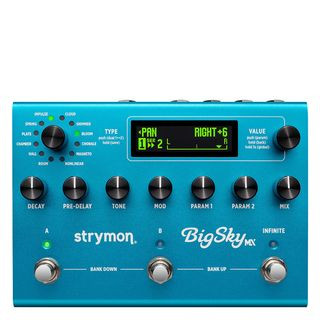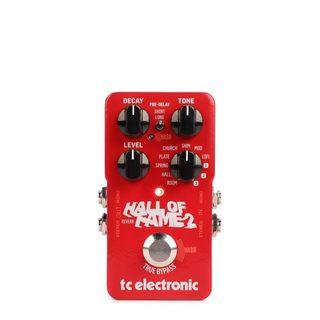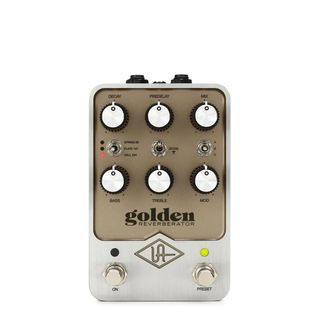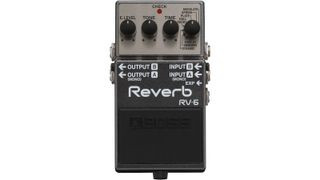Reverb is more than just an effect—it’s an essential ingredient in crafting captivating guitar tones. Whether you’re aiming for a subtle touch of warmth to enrich your clean sound or a vast, ethereal wash to transport your listeners to another dimension, a great reverb pedal is indispensable. It’s the secret weapon for adding dimension and emotion to your playing, making it a cornerstone effect for guitarists across genres. The Best Guitar Reverb Pedals are those that seamlessly blend user-friendliness with a wide range of sonic possibilities and, above all, deliver exceptional sound quality. This effect isn’t just beloved by guitarists; it’s a fundamental tool in music production across the board, proving its timeless appeal and versatility.
A reverb pedal, at its core, is designed to simulate the acoustic ambiance of a physical space around your guitar. Imagine the rich echoes you hear when you strum a chord in a concert hall or the subtle reflections in a cozy room. That’s precisely what a reverb pedal replicates for your instrument. It artificially creates the sonic reflections and decays that would naturally occur in various environments, adding depth, space, and character to your dry guitar signal.
The market is flooded with an overwhelming variety of reverb pedals, each promising a unique sonic signature. From emulations of classic spring reverbs found in vintage amplifiers to expansive, modulated textures that seem to stretch into infinity, the choices can be daunting. Finding the best guitar reverb pedal for your specific needs and musical style requires careful consideration and research, especially given that many high-quality reverb pedals represent a significant investment.
To guide you through this sonic landscape, we’ve compiled a list of top-tier reverb pedals, catering to diverse needs and budgets. Before diving into our curated selection, stick around to the end of this article for our expert buying advice, designed to equip you with the knowledge to make an informed decision. But if you’re ready to explore our recommendations right now, keep scrolling to discover our top picks for the best reverb pedals available today.
Best Reverb Pedals: Our Top Picks
- Strymon BigSky – Best Overall
 Best reverb pedal
Best reverb pedal - TC Electronic Hall Of Fame 2 – Best Budget
 Best reverb pedal
Best reverb pedal - Universal Audio UAFX Golden Reverberator – Best Studio
 Best reverb pedal
Best reverb pedal - Boss RV-6 – Best Digital Reverb
 Best reverb pedals: Boss RV-6
Best reverb pedals: Boss RV-6 - Electro-Harmonix Oceans 11 Reverb – Best for Shoegaze
- JHS Spring Tank – Best Spring Reverb
- Eventide Space – Best for Versatility
- Source Audio Ventris Dual Reverb – Best Dual Reverb
- MXR M300 Reverb – Best for Simplicity
- Boss RV-500 – Best Multi-Reverb
Best Overall
1. Strymon BigSky
The best reverb pedal for anyone seeking the highest quality and most expansive sonic textures.
Read our expert review of the Strymon BigSky
Specifications:
- Controls: Value, Decay, Pre-Delay, Mix, Tone, Param 1, Param 2, Mod, Type, Bank Up/Down, Tap
- Sockets: Stereo In/Out, Expression pedal in, MIDI in/out
- Bypass: True bypass
- Power requirements: 300mA 9V DC
Reasons to Buy:
- Jaw-dropping, pristine sounds
- Packed with features and extensive tweakability
- High-quality, robust build
Reasons to Avoid:
- Significant investment, may be overkill for players needing basic reverb
The Strymon BigSky has rapidly become an industry standard, favored by professional guitarists across diverse genres. If budget isn’t a primary concern and you demand unparalleled reverb quality and versatility, the BigSky is undoubtedly the best reverb pedal for you. Strymon’s meticulous research and engineering are evident in every algorithm, resulting in a pedal that sounds nothing short of extraordinary.
The BigSky boasts 12 distinct reverb machines, offering a spectrum of sonic textures ranging from incredibly natural and realistic spaces to otherworldly, ethereal soundscapes. Its atmospheric capabilities have made it a staple among post-rock musicians, but its adaptability extends far beyond a single genre. This pedal seamlessly integrates into any musical context, delivering consistently convincing and inspiring reverb tones.
Functionality is where the BigSky truly shines. Its extensive parameter controls allow for deep dives into shaping your reverb sound, but it’s the sheer sonic quality that truly justifies its premium price tag. The reverbs are lush, detailed, and responsive, elevating your playing and inspiring new creative avenues. If you’re on a quest for the ultimate reverb pedal to be the centerpiece of your board, the Strymon BigSky is it.
Read our full Strymon BigSky review
Best on a Budget
2. TC Electronic Hall Of Fame 2
The best reverb pedal delivering exceptional value without compromising on sound quality.
Read our expert review of the TC Electronic Hall Of Fame 2
Specifications:
- Controls: Decay, Level, Tone, Type
- Sockets: Stereo input and output, USB
- Bypass: True bypass (switchable to buffered)
- Power requirements: 100mA 9V DC
Reasons to Buy:
- Excellent, high-quality reverb sounds across the board
- Shimmer mode is particularly impressive
- TonePrint feature expands versatility
Reasons to Avoid:
- MASH footswitch functionality might feel somewhat limited to some users
The original TC Electronic Hall Of Fame set a high bar for affordable, versatile reverb pedals, offering a “kitchen-sink” approach with a wide array of reverb types and the innovative TonePrint feature. TonePrint allows you to download custom reverb profiles created by renowned artists, significantly expanding the pedal’s sonic palette.
The Hall Of Fame 2 builds upon this legacy, introducing a new shimmer octave reverb mode, adding ethereal and shimmering textures to your sound. It also incorporates the ‘MASH’ footswitch, a pressure-sensitive footswitch that acts like an expression pedal, allowing for real-time control over reverb parameters. Despite these additions, the core strength of the Hall Of Fame 2 remains its exceptional reverb sounds. It covers all essential reverb types with remarkable quality, making it the best reverb pedal for players seeking premium sound on a budget. For its price point, the Hall Of Fame 2 delivers incredible value and performance, making professional-sounding reverb accessible to everyone.
Read our full TC Electronic Hall Of Fame 2 review
Best Studio Verb
3. Universal Audio UAFX Golden Reverberator
The best reverb pedal for capturing classic studio and amplifier reverb tones in a pedal format.
Read our expert review of the Universal Audio UAFX Golden Reverberator
Specifications:
- Controls: Decay, Pre-delay, Bass, Treble, Modulation, Mix; Toggle switches for effect type, preset store and sound A/B/C; Manual/bypass and preset/bypass footswitches
- Sockets: Stereo input and outputs, USB-C for firmware upgrades
- Bypass: True bypass (switchable to buffered)
- Power requirements: 9V DC (minimum 400mA draw)
Reasons to Buy:
- Top-tier digital emulations of classic studio reverbs
- Exceptional plate reverb sounds, arguably the best in pedal format
- Perfect for achieving authentic, vintage-inspired reverb tones
Reasons to Avoid:
- No MIDI integration for advanced control
- Limited to one onboard preset
The Universal Audio UAFX Golden Reverberator sets a new benchmark for bringing premium studio-quality reverb emulations to your pedalboard. Universal Audio, renowned for their industry-leading plugins and hardware, has successfully translated their expertise into a compact pedal format. This pedal focuses on delivering meticulously crafted emulations of classic spring, plate, and hall reverbs, each category offering three distinct variations.
Channeling the company’s plugin prowess, the Golden Reverberator provides access to iconic reverb sounds from vintage Fender spring tanks to the legendary EMT 140 plate reverb. Beyond the nine onboard algorithms, users can expand their sonic palette via the UA Control app, unlocking additional reverbs, including extra plate and chamber emulations.
The Golden Reverberator offers precise control over frequency response, allowing you to maintain clarity in your mix, even with lush reverb tails. The wide range of pre-delay allows for fine-tuning your picking attack within the reverb’s space. For players seeking the authentic sound of classic studio reverbs in a pedal format, the Golden Reverberator is a worthwhile investment, delivering tones that rival the original hardware units costing thousands more. It’s truly the best reverb pedal for studio-quality sound on your pedalboard.
Read our full Universal Audio UAFX Golden Reverberator review
Best Digital Reverb
4. Boss RV-6
A versatile and incredibly valuable compact stompbox offering a wide range of high-quality digital reverbs.
Read our expert review of the Boss RV-6 Reverb
Specifications:
- Controls: Level, Tone, Time, Mode
- Sockets: Stereo In/Out, Expression In
- Bypass: Buffered bypass
- Power requirements: 100mA 9V DC
Reasons to Buy:
- Outstanding value for money within its class
- Superb overall sound quality across various reverb modes
- Robust and reliable Boss construction
Reasons to Avoid:
- No preset selection for quick sound changes
The Boss RV-6 marks a significant leap forward from its predecessor, boasting completely redesigned algorithms and an updated DSP engine. The RV-6 has become a mainstay on many pedalboards due to its exceptional value and the sheer number of high-quality reverb types it offers for the price. It stands out as one of the best reverb pedals in its category for delivering professional sound in a compact and affordable package.
Standout modes include the Shimmer, which adds an ethereal, synth-like quality with octave-up voices, and the Modulated mode, providing a warm, dynamic wash of reverb with subtle movement. The RV-6 also features a Dynamic mode that intelligently responds to your playing dynamics, and a Delay+Reverb mode for added versatility.
The inclusion of an expression pedal input expands its real-time control, allowing for swells and on-the-fly reverb adjustments. Housed in the iconic, road-ready Boss enclosure, the RV-6 is built to last. While the Spring mode might be slightly splashier than some dedicated spring reverb pedals, the overall quality and versatility of the RV-6 make it a minor trade-off.
Read the full Boss RV-6 review
Best for Shoegaze
5. Electro-Harmonix Oceans 11 Reverb
The best reverb pedal for creating expansive, dreamy soundscapes favored by shoegaze and ambient musicians.
Read our expert review of the Electro-Harmonix Oceans 11 Reverb
Specifications:
- Controls: FX Level, Time, Type, Tone, Mode switch
- Sockets: In, Out, Infinite footswitch input
- Bypass: Buffered
- Power requirements: 9V 150mA
Reasons to Buy:
- Impressive variety of reverb algorithms for its compact size
- Excellent octave shimmer and modulated reverb sounds
- Infinite sustain footswitch option for ambient textures
Reasons to Avoid:
- Secondary control functions can be slightly less intuitive to access
Considering its price point, the Electro-Harmonix Oceans 11 Reverb punches well above its weight. Don’t let its affordability fool you—it’s packed with a plethora of reverb algorithms, from modulated and shimmer to more unconventional options like polyphonic octave, echo, reverse, and standard reverbs like plate, spring, and hall.
The reverse reverb mode is a particular highlight, catering to the resurgence in popularity among shoegaze and experimental musicians. This mode alone makes the Oceans 11 a strong contender for the best reverb pedal in this category. It excels at creating dreamy, swirling textures and adding a unique, psychedelic edge to your playing. Beyond the reverse, the core hall and plate sounds are also remarkably good, making it far more than just a one-trick pony. The Oceans 11 is a versatile and inspiring tool for players exploring ambient, shoegaze, and experimental genres.
Read our full Electro-Harmonix Oceans 11 Reverb review
Best Spring Reverb
6. JHS Spring Tank
The coolest and most feature-rich spring reverb pedal, capturing the authentic splash and character of vintage spring reverb tanks.
Our expert review: (Review link missing in original text, consider adding a relevant link if available)
Specifications:
- Controls: Boost, Highs, Tank 1, Length, Depth, Tank 2
- Sockets: In, Out, Effects Loop
- Bypass: True bypass
- Power requirements: 73mA 9V DC
Reasons to Buy:
- Offers two footswitchable spring reverb settings
- Incorporates an effects loop for unique reverb tail modulation
- Delivers authentic and inspiring spring reverb sound
Reasons to Avoid:
- Exclusively focused on spring reverb, lacking versatility for other reverb types
The JHS Spring Tank stands out as one of the most comprehensive and feature-laden spring reverb pedals available. It meticulously recreates the iconic sound of a physical spring reverb tank, which was integral to the sound of early rock and roll and surf music. It’s designed to capture both subtle, always-on spring reverb ambiance and more pronounced, in-your-face spring effects, making it the best reverb pedal for spring aficionados.
A key feature is the dual footswitchable reverb settings, allowing you to instantly switch between two distinct spring reverb tones. You have extensive control over the reverb character, including reverb tail length and “room” size simulation. A Highs control lets you shape the high-frequency content of the reverb, and a Boost control allows for level adjustments relative to the dry signal or reverb tail.
A unique addition is the built-in effects loop, enabling you to insert other effects pedals into the reverb path, opening up creative possibilities for modulating and shaping the reverb tails. If you’re specifically seeking the authentic and versatile sound of spring reverb, the JHS Spring Tank is an exceptional choice.
Best for Versatility
7. Eventide Space
The best reverb pedal for players who demand maximum sonic versatility and a vast palette of ambient textures.
Read our expert review of the Eventide Space
Specifications:
- Controls: Mix, Decay, Size, Delay, Low, High, Preset, Xnob, Ynob, FxMix, Contour, Bank up/down, Tap
- Sockets: Stereo in/out, Expression pedal, Aux, In Lvl: Guitar/line, Out Lvl: Amp/line, USB, MIDI In/Out
- Bypass: DSP Bypass, Relay Bypass or DSP+FX Bypass
- Power requirements: 500mA 9V DC
Reasons to Buy:
- Unmatched sound quality derived from Eventide’s rackmount processors
- Extensive adjustability and deep parameter control
- Comprehensive foot control capabilities for live performance
Reasons to Avoid:
- Steep learning curve due to its vast feature set
- Higher price point compared to less versatile reverb pedals
The Eventide Space packs the power of Eventide’s renowned H8000FW and Eclipse V4 rackmount processors into a pedal format, offering an unparalleled level of sonic versatility. It features 12 distinct effects algorithms, ranging from pure reverbs to combinations of reverb with delays, pitch-shifting, tremolo, modulation, and spatial effects. If you’re looking for a single stompbox to cover a wide spectrum of reverb and ambient textures, the Space is arguably the best reverb pedal for comprehensive versatility.
For studio use, the Space truly shines in stereo, unlocking its full potential for creating immersive and expansive soundscapes. While the price is higher than many other reverb pedals, consider it an investment in a professional-grade reverb processor in pedal form. Compared to rackmount units or high-end plugins, the Space offers incredible value, especially considering its exceptional sound quality and vast creative potential.
Read our full Eventide Space review
Best Dual Reverb
8. Source Audio Ventris Dual Reverb
A highly flexible dual reverb pedal offering two independent reverb engines in a pedalboard-friendly footprint.
Read our expert review of the Source Audio Ventris Dual Reverb
Specifications:
- Controls: Time, Type, Mix, Pre-delay, Treble, Control 1, Control 2
- Sockets: Stereo in/out, MIDI in/out, USB, Expression pedal in, Control input
- Bypass: True or buffered bypass
- Power requirements: 280mA 9V DC
Reasons to Buy:
- Two powerful, independent reverb engines in one pedal
- Wide range of dual routing options for creative sound design
- Relatively compact footprint for a dual reverb pedal
- User-friendly, hands-on operation
Reasons to Avoid:
- Neuro app required for accessing in-depth parameter editing and additional algorithms
The Source Audio Ventris Dual Reverb offers a unique solution for players seeking complex reverb textures and routing possibilities without sacrificing pedalboard space. It houses two completely independent reverb engines that can be used individually or combined in parallel, series, or left/right configurations, with various mono and stereo operation modes. This makes it the best reverb pedal for intricate, layered reverb soundscapes.
The Ventris features 12 onboard reverb algorithms accessible directly from the front panel. However, like other Source Audio pedals, the Neuro software unlocks a deeper level of customization and access to additional reverb algorithms. The initial impression of the Ventris is its exceptional reverb quality. Despite its powerful features, it maintains a pedalboard-friendly size and straightforward, hands-on controls. For those who want to delve deeper, the Neuro app provides extensive editing capabilities. But even straight out of the box, the Ventris offers a wealth of inspiring reverb tones and routing options.
Read our full Source Audio Ventris review
Best for Simplicity
9. MXR M300 Reverb
One of the best reverb pedals for players who prioritize ease of use and a streamlined interface without sacrificing sound quality.
Our expert review: (Review link missing in original text, consider adding a relevant link if available)
Specifications:
- Controls: Decay, Tone (acts as push button), Mix
- Sockets: In, Out, Expression In
- Bypass: True bypass (with trails bypass mode)
- Power requirements: 240mA 9V DC
Reasons to Buy:
- Superb quality reverb tones across all algorithms
- Six distinct and highly usable reverb types
- Incredibly simple and intuitive user interface
Reasons to Avoid:
- Stereo setup can be less straightforward compared to other pedals
The MXR M300 Reverb excels at packing a wide range of high-quality reverb sounds into a compact pedal with an incredibly simple interface. It avoids menu-diving and complex controls, opting for a straightforward three-knob layout, with the Tone knob also functioning as a push-button to cycle through reverb types. For players who value simplicity and ease of use, the M300 is arguably the best reverb pedal in its class.
Despite its minimalist design, the M300 offers six distinct reverb algorithms, all of which are exceptionally well-voiced and versatile. The Spring, Room, and Plate modes are perfect for everyday reverb needs, adding subtle texture and depth to your tone. The Pad mode conjures up dreamy, ambient, and almost synth-like textures. For players who want a range of high-quality reverb options without a complex interface, the MXR M300 is an excellent choice.
Read the full MXR Reverb M300 review
Best Multi-Reverb
10. Boss RV-500
A comprehensive reverb and delay workstation in a single stompbox, offering extensive control and a vast sonic palette.
Read our expert review of the Boss RV-500
Specifications:
- Controls: Mode, Time/Value, Pre-Delay, E. Level, Low, High, Bank Up/Down, Tap
- Sockets: Stereo In/Out, Expression pedal in, USB, MIDI In/Out
- Bypass: Buffered Bypass or True Bypass
- Power requirements: 225mA 9V DC
Reasons to Buy:
- Highly flexible switching and routing options
- Integrated delay effect alongside each reverb algorithm
- Includes a dedicated Space Echo emulation mode
Reasons to Avoid:
- Menu-based interface may be less immediate for some users when setting up sounds
The Boss RV-500 can be considered Boss’s answer to pedals like the Strymon BigSky, offering a comprehensive reverb toolbox in a single unit. With three footswitches, 12 reverb modes, and integrated digital delay options, along with a vast array of editable parameters, the RV-500 provides a seemingly endless range of tonal possibilities. It’s the best reverb pedal for players who need a wide variety of reverb and delay sounds in a single, performance-ready unit.
The RV-500 delivers the classic, high-quality reverb sounds that Boss and Roland are known for. It also includes a dedicated Space Echo multi-head tape delay emulation, adding even more versatility. The integration of delay with each reverb algorithm makes it a powerful tool for creating complex ambient textures. With extensive memory and footswitching options, the RV-500 is ideal for players who require different ambient sounds for various songs or song sections.
Read our full Boss RV-500 review
FAQs
How do I choose the right reverb pedal for my needs?
Investing in a reverb pedal is a significant decision, so carefully consider your specific requirements. Are you seeking vintage-inspired tones reminiscent of classic rock records? Or are you more drawn to experimental and unique reverb textures? Some pedals excel at both, while others specialize in particular sonic niches. Think about the genres you play, the types of reverb you envision using, and your budget to narrow down your choices and find the best guitar reverb pedal for you.
How does a reverb pedal actually work?
A reverb pedal uses digital signal processing to simulate the acoustic properties of a physical space. Much like clapping your hands in a large room creates echoes as sound waves reflect off surfaces, a reverb pedal recreates these reflections for your guitar signal. It artificially generates the sonic characteristics of different environments, from small rooms with short reflections to vast halls with long, decaying reverberations. This effect can add subtle warmth and depth to a clean tone or create expansive, otherworldly soundscapes. Reverb is incredibly versatile and is a staple effect on countless guitarists’ pedalboards.
Where should I place my reverb pedal in my signal chain?
While there are no hard and fast rules for pedal order, and experimentation is encouraged, reverb pedals are generally placed towards the end of the signal chain. Typically, it’s positioned as the last pedal before your amplifier. This placement is because reverb is a time-based effect. Placing it earlier in the chain, before effects like distortion or modulation, can sometimes make your entire signal sound distant or washed out. However, some players intentionally place reverb before fuzz or distortion to create unique, droning textures. Ultimately, experimenting with pedal order is key to discovering your own preferred sound.
What’s the difference between digital and analog reverb pedals?
Reverb is predominantly a digital effect because true analog reverb relies on physical spaces. Original plate reverbs used large vibrating metal sheets. Analog spring reverbs use physical springs to create their characteristic sound. Echo chambers required playing sounds into a physical room and capturing the reflections with microphones.
Consequently, true analog reverb pedals are rare. Unless you’re prepared to carry around metal plates or springs, achieving analog reverb in pedal format is challenging. Some pedals, like those from Danelectro and Gamechanger Audio, incorporate actual springs, but these are exceptions. For the most part, achieving analog reverb sounds in a pedal format relies on digital emulations.
Are there any affordable, high-quality reverb pedals available?
Reverb pedals tend to be among the more expensive effects due to the complex algorithms and powerful processing chips required. Accurately simulating the intricate reflections and decays of reverb in real-time demands significant processing power. While there are budget-friendly reverb pedals on the market, it’s generally true that with reverb, you often get what you pay for. Higher-priced pedals typically offer more refined algorithms, greater sonic depth, and more versatile features. However, pedals like the TC Electronic Hall Of Fame 2 demonstrate that excellent reverb can be achieved at more accessible price points.
How We Chose the Best Reverb Pedals for This Guide
At guitarplayers.net, our content is crafted by experienced musicians and gear experts with years of hands-on experience playing, recording, and testing music equipment. We live and breathe music gear and draw upon our extensive knowledge and real-world usage in live, recording, and rehearsal settings when curating our product guides.
Our selection process for the best reverb pedals involves a combination of factors: in-depth hands-on testing, analysis of user reviews and testimonials from across the web, and detailed discussions with our editorial team. We strive to reach a consensus on the top products in each category, considering factors like sound quality, versatility, features, ease of use, build quality, and value for money.
Our primary goal is to help fellow musicians find the right gear for their needs and musical styles. We carefully consider various budgets and feature sets to create comprehensive guides that offer valuable recommendations for players of all levels. We are committed to providing helpful, unbiased, and expert advice to empower you in your gear purchasing decisions.
Find out more about how we test music gear and services at MusicRadar.

